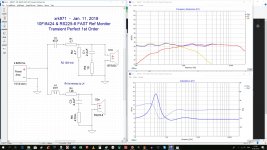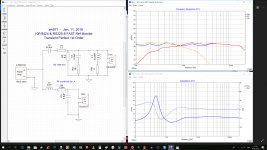A first order high pass crossover isn't quite enough to limit excursion on any driver. So while the 10F can't really do as much bass as a genuine woofer, a first order crossover isn't going to stop it from trying. As we know it's a lot smaller in diameter, guess what it will be doing  .
.
The natural roll off will steepen the slope, making it deviate from the envisioned first order crossover behaviour, however you're still feeding it energy that's asking it to move more and more, the lower you go.
Once you get 20 dB below the target SPL, you could make it drop faster without influencing the summing much, but it's save to say that shouldn't happen at 50 Hz but way above that point.
The natural roll off will steepen the slope, making it deviate from the envisioned first order crossover behaviour, however you're still feeding it energy that's asking it to move more and more, the lower you go.
Once you get 20 dB below the target SPL, you could make it drop faster without influencing the summing much, but it's save to say that shouldn't happen at 50 Hz but way above that point.
Experimenting with a 4mH DCR=0,12Ohm
Dear all!
I am planning to build the FAST speaker, but I thought that a 1,21 Ohm coil for the woofer is too big value, I wanted to go lower. I found some company, who could produce some custom made coil for me, with a DCR of 0,12 Ohm, it is 5mm thick wire...
Introducing such a coil to crossover made the frequency at 100-200 Hz go up more than 1dB. So I had to alter things a bit. I started with the padding of the Scan Speak, I had to raise it in gain, but just reducing the padding was not enough, above all it was necessary to bring the mid frequencies up, I kind of rotated the frequency response a bit (bring the mids up, high down - and bring it all up). In order to get the low frequencies below the XO of the scan speak down, I introduced another coil in parallel.
See attached two pictures. If you download them, and open it with your installed picture viewer, and toggle between them, you will easily catch the differences. In my altered crossover version, the whole sensitivity is like 1dB up, and I think I quite successfully managed to bring it as flat as it was.
But there is one thing I noticed, and I would like to ask you, what you think about it: The frequency plot especially of the woofer, and the frequency plot of the whole system - they are separated from each other more. So the gap between the blue graph and (each) driver graph next below and above the XO is bigger. Can anyone tell me what this means in terms of sound quality?
I got so far: The sum of the drivers (blue) = speaker, is the sum of each driver. And actually the two drivers do sum to a bigger gain. For example if one skips the second coil in parallel to the Scan Speak (it brings the plot even more down below 200Hz), the Scan Speak will have more response in the bass, and there the sum will be higher - as one will expect. But: Why is the sum still below the woofer's response alone? If the Scan Speak substracts from the woofer, and I bring up the volume of the Scan Speak - the sum should acutally go down even more, no? Is this because of an absolute phase difference between the two drivers? What does this mean to the sound?
Thank you for responding, I am rather new here, but want to learn more...!
Best regards,
Florian
Dear all!
I am planning to build the FAST speaker, but I thought that a 1,21 Ohm coil for the woofer is too big value, I wanted to go lower. I found some company, who could produce some custom made coil for me, with a DCR of 0,12 Ohm, it is 5mm thick wire...
Introducing such a coil to crossover made the frequency at 100-200 Hz go up more than 1dB. So I had to alter things a bit. I started with the padding of the Scan Speak, I had to raise it in gain, but just reducing the padding was not enough, above all it was necessary to bring the mid frequencies up, I kind of rotated the frequency response a bit (bring the mids up, high down - and bring it all up). In order to get the low frequencies below the XO of the scan speak down, I introduced another coil in parallel.
See attached two pictures. If you download them, and open it with your installed picture viewer, and toggle between them, you will easily catch the differences. In my altered crossover version, the whole sensitivity is like 1dB up, and I think I quite successfully managed to bring it as flat as it was.
But there is one thing I noticed, and I would like to ask you, what you think about it: The frequency plot especially of the woofer, and the frequency plot of the whole system - they are separated from each other more. So the gap between the blue graph and (each) driver graph next below and above the XO is bigger. Can anyone tell me what this means in terms of sound quality?
I got so far: The sum of the drivers (blue) = speaker, is the sum of each driver. And actually the two drivers do sum to a bigger gain. For example if one skips the second coil in parallel to the Scan Speak (it brings the plot even more down below 200Hz), the Scan Speak will have more response in the bass, and there the sum will be higher - as one will expect. But: Why is the sum still below the woofer's response alone? If the Scan Speak substracts from the woofer, and I bring up the volume of the Scan Speak - the sum should acutally go down even more, no? Is this because of an absolute phase difference between the two drivers? What does this mean to the sound?
Thank you for responding, I am rather new here, but want to learn more...!
Best regards,
Florian
Attachments
The lower R of the thick gauge wire will give more authoritative bass, but it may shift the natural driver box fs higher. You just need to redo the simulation and adjust it to match. I don’t think it’s a huge effect. A could with 5mm wire so very expensive though vs 18ga Jantzen 4mH coil that’s about $20.
Yes, the coils will be quite expensive...I dont have an offer yet, but I could imagine 500 Euro for both. I have already found a 3mm wire for 260 Euro both, this is DCR = 0,2.
A great, that did not come to my mind.... I just had to make the box a bit bigger, right? When I adjusted the box, and the frequency plot is flat again - will then there be a noticeable difference in sound (e.g. dynamics) due to the lower DCR?
Thank you,
Florian
A great, that did not come to my mind.... I just had to make the box a bit bigger, right? When I adjusted the box, and the frequency plot is flat again - will then there be a noticeable difference in sound (e.g. dynamics) due to the lower DCR?
Thank you,
Florian
Those speakers came out great, a lot of people are trying the fast thing these days.
This might have already come up (didn't read the full 130 pages) but I'm interested in why you went to the 1st order crossover instead of the mini dsp? I assume that you'd have a mid range bump due to mutual coupling, and also some lobing up top from the series crossover.
Also did you test whether you need to do separate internal chambers? If the smaller cone is still getting enough low frequency signal at the bottom then in theory it doesn't need a separate chamber.
I have a set up now with an aurasound whisper and a hivi m8n. The m8n is a good alternative to the rs225, but is less damped and breaks up pretty fast. I was thinking about getting something like a 10f or dayton ps95 but there is no separate chamber in the box.
BTW thanks for all the drivers tests. I am by no means an expert, but I am starting to think that its always better to crossover before a driver enters break up. And if a driver is in breakout it will inevitably sound like what its made out of, even with equalization. So listening to a driver is the most important criteria.
This might have already come up (didn't read the full 130 pages) but I'm interested in why you went to the 1st order crossover instead of the mini dsp? I assume that you'd have a mid range bump due to mutual coupling, and also some lobing up top from the series crossover.
Also did you test whether you need to do separate internal chambers? If the smaller cone is still getting enough low frequency signal at the bottom then in theory it doesn't need a separate chamber.
I have a set up now with an aurasound whisper and a hivi m8n. The m8n is a good alternative to the rs225, but is less damped and breaks up pretty fast. I was thinking about getting something like a 10f or dayton ps95 but there is no separate chamber in the box.
BTW thanks for all the drivers tests. I am by no means an expert, but I am starting to think that its always better to crossover before a driver enters break up. And if a driver is in breakout it will inevitably sound like what its made out of, even with equalization. So listening to a driver is the most important criteria.
Last edited:
Doesn't sound like a good idea to me. Both drivers will get the total acoustic pressure (included resonances, ...) in the enclosure and radiate it to the outside with presumably less than ideal accuracy.[...] If the smaller cone is still getting enough low frequency signal at the bottom then in theory it doesn't need a separate chamber.
[...]
Wow. Is there a reason not going fully active, at these costs?Yes, the coils will be quite expensive...I dont have an offer yet, but I could imagine 500 Euro for both. I have already found a 3mm wire for 260 Euro both, this is DCR = 0,2.[....]
Two plate amps from Hypex wouldn't cost much more than your crossovers...
DIYclassd.com
Not speaking about the flexibility you get.
Hi Sottomano,
I would like to go passive, as I don't like Minidsp (AD and DA converters), and I would like to form the sound, use my own AB amp. It's a SAKSA 85 from Aspen Amplifier, I can recommend these amps. It is the same engineer how designed XRKs Alpha 20 Amplifier... really good amps with an intended harmonic distortion profil.
I would like to go passive, as I don't like Minidsp (AD and DA converters), and I would like to form the sound, use my own AB amp. It's a SAKSA 85 from Aspen Amplifier, I can recommend these amps. It is the same engineer how designed XRKs Alpha 20 Amplifier... really good amps with an intended harmonic distortion profil.
This might have already come up (didn't read the full 130 pages) but I'm interested in why you went to the 1st order crossover instead of the mini dsp? I assume that you'd have a mid range bump due to mutual coupling, and also some lobing up top from the series crossover.
I originally used miniDSP and it works amazingly well. A real game-changer for anyone into DIY for sure. I then got into building my own amps and wanted a passive reference speaker to test my amps and to be able to compare amps sound quality with a fixed speaker. The only route was passive and why 1st order? To give it the ability to be 'transient perfect' (note that nothing is ever "perfect"). This affects the timing and phase of the signals from full range and the woofer. When they are aligned it sounds very realistic, especially for ambient mic'd small ensembles, jazz trios, cafe's etc. It is particularly important for drums, guitar, piano, etc. Once you hear a transient perfect speaker, you can't go back (at least I can't). But if you haven't heard one, you just don't know what you don't know. Sort of like an LCD/LED 1080p HD TV - can you ever go back to 425 lines NTSC broadcast on CRT? Now we have 4k TV...
So why 1st order?
The truth is that 99.5% of all commercial multiway speakers are not transient perfect. And most people don't know what it really should sound like.
Here is a step response of perhaps one of a handful of commercial speakers measured by Stereophile that is transisent perfect (Dunlavey SC-IV):
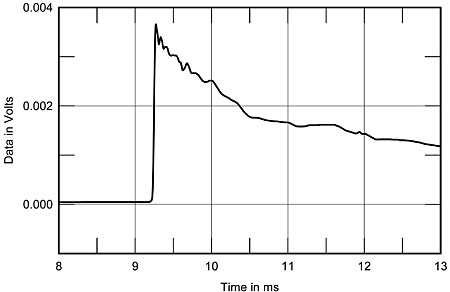
The ideal shape is a right triangle.
Here is the measured step response for a very highly regarded $22k/pair speaker by B&W (820D3) also by Stereophile:
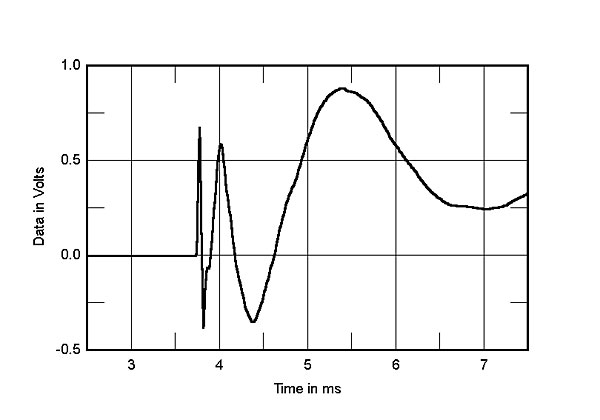
Note that all the peaks seem to arrive at different times. What do you think that does to the sound of a percussive pluck, rim shot, snare drum, piano strike, etc?
That's why I am using a 1st order XO.
Here is the measured step response for the 10F/RS225 with 1st order XO:
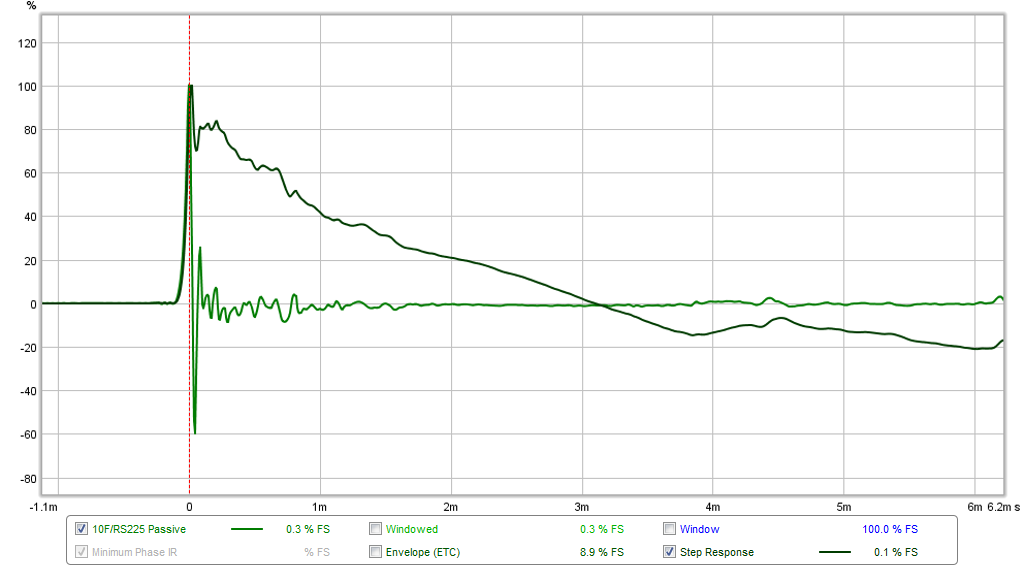
Some of you will point out that this is only true for one spot in the room as the speakers are not coaxial point source. True, but it is not far off if you wander off the sweet spot by 3 feet either. It certainly doesn't look anything like what a Linkwitz-Riley 2nd order looks like.
Last edited:
Dear XRK,
I am reading more and more of these interesting 130 pages, once you wrote this:
Can you please give a source where to find a PMC style labyrinth TL? Where do I have to look, what shall I look and search for, is it hard to design one? I was thinking about bassreflex also, now read what you wrote above, thinking about a TL now. - Thank you!
I am reading more and more of these interesting 130 pages, once you wrote this:
Hi Jessman,
That looks really nice and a good way to get deeper bass. My only concern is that the bass from a BR is not going to be tight from a time alignment standpoint. You get a lot of group delay (GD) at the lower frequencies and the sound of drum may not be as coherent.
If you want to do a stepped baffle with the tweeter on top, put the Dagger externally on its own trapezoidal baffle and move it back 3in.
Another option is to use dual RS225-8 in parallel (in 50L box) and then decrease padding on tweeter.
And yet another option is a tapered and stuffed PMC style labyrinth TL. Deep and tight low GD bass.
But, from simplicity standpoint - your tower BR is pretty good. It is tall enough to be ML-TL and that will sound better than a BR of same size.
Can you please give a source where to find a PMC style labyrinth TL? Where do I have to look, what shall I look and search for, is it hard to design one? I was thinking about bassreflex also, now read what you wrote above, thinking about a TL now. - Thank you!
I understand not wanting to go DSP and Class D, however Hypex is not MiniDSP...Hi Sottomano,
I would like to go passive, as I don't like Minidsp (AD and DA converters), and I would like to form the sound, use my own AB amp. It's a SAKSA 85 from Aspen Amplifier, I can recommend these amps. It is the same engineer how designed XRKs Alpha 20 Amplifier... really good amps with an intended harmonic distortion profil.
Since there seems to be a trend here towards 6dB Filters, I suggest to buy another Stereo Amp or two Monoblocks for the woofers, and filter them actively. You won't get any simpler than that. And better than any huge coil for the bass. Do you need baffle step correction too? Other networks for the F10 can be done passively still.
To filter actively probably means to use OP-amps, which I do not want, furthermore I can't afford another same amplifier - then the coils are indeed a lot cheaper.
No, I do not do any further baffle step correction, I plan to use XRKs crossover, I will just make the box a bit bigger in respect to the different behaviour of the woofer due to lower DCR. But I have not decided yet, a TL also seems interesting to me.
What is F10?
No, I do not do any further baffle step correction, I plan to use XRKs crossover, I will just make the box a bit bigger in respect to the different behaviour of the woofer due to lower DCR. But I have not decided yet, a TL also seems interesting to me.
What is F10?
Dear XRK,
I am reading more and more of these interesting 130 pages, once you wrote this:
Can you please give a source where to find a PMC style labyrinth TL? Where do I have to look, what shall I look and search for, is it hard to design one? I was thinking about bassreflex also, now read what you wrote above, thinking about a TL now. - Thank you!
A PMC style TL simply means take a tapered TL and fold it in a labyrinth to get a compact box with the vent coming out the front but on the bottom below the woofer. The TL needs to be designed or modeled. I have designed a 5.25in driver PMC style TL in this thread here so you can see what I mean.
Low-Cost PMC-inspired TL Monitor with DC130A and DC28F
But if you look here, there is a nice design for a dual RS225 12:1 tapered TL. You would need to fold that or just do a single fold for a 35in tall tower speaker.
Help Needed - 2x rs225s-8 bass bin Transmission Line -
Techtalk Speaker Building, Audio, Video Discussion Forum
With 92dB sensitivity after 5dB baffle step loss you have a 87dB system and perfect match for 10F no padding needed.
I think F10 refers to the frequency for the -10dB point for the bass response.
You dont need op amps for active filters, just unity gain buffers. For further enlightment in this area, read up Nelson Pass' article on the First Watt site. http://www.firstwatt.com/pdf/art_lxmini crossover.pdf
However, for 6dB slopes you don't even need a buffer, just some resistors and two film capacitors per channel, your buffers being the pre out and power amp input. Furthermore, you do not need the same amp for Bass. A cheaper one will do when crossing low. Sure cheaper than USD 500 for coils. And sounding way better.
Just my last 2cents.
F10...I meant 10F.
However, for 6dB slopes you don't even need a buffer, just some resistors and two film capacitors per channel, your buffers being the pre out and power amp input. Furthermore, you do not need the same amp for Bass. A cheaper one will do when crossing low. Sure cheaper than USD 500 for coils. And sounding way better.
Just my last 2cents.
F10...I meant 10F.
I have already use a complete passive XO between pre and power amp, and was not satisfied. I dont know why, perhaps it had to do with the output and input impedances. I could give it another try, but still I needed two stereo power amps, which is a lot more expensive than that two bigger coils. Aspen Amplifiers have a remarkable bass production, full rich and warm, I don't want to go for a perfect controlled hypex class D. Apart of that - with a 6dB XO at 700Hz the sound will be not good if mixed of two different amps, at least this is my opinion.
You can use a less expensive amp for subwoofer 80Hz and below, but on a FAST system, the woofer goes all the way up to 7kHz or so since the slope is very shallow. The crossover on a 1st order really uses both drivers over several octaves on either side of the XO. So it is important that high quality amps be used for both channels. I don’t think you need expensive low DCR coils. You should first build the system like I describe using a $20 coil. Listen to it and see if it sounds good. I have spent a lot of time designing that XO and testing it. It is nearly perfect when used as designed with RS225-8 and 10F/8424. Both drivers are incredibly flat smooth and wide band. That’s what you need for. Good 1st order XO. The breakup at 7kHz is attenuated with the 4.4uF and 0.51R across the woofer terminals. But it hardly costs anything compared to a custom low DCR coil to try it. I suggest you build it to plan, and if modifying anything - adding a tapered TL to the woofer is ok but keep box baffle width the same.
- Home
- Loudspeakers
- Full Range
- 10F/8424 & RS225-8 FAST / WAW Ref Monitor
